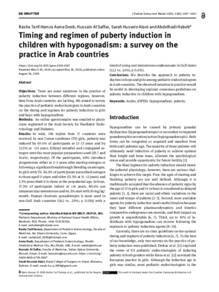Document
Timing and regimen of puberty induction in children with hypogonadism : a survey on the practice in Arab countries.
Identifier
DOI: 10.1515/jpem-2020-0157
Source
Journal of Pediatric Endocrinology and Metabolism. v. 33, 9, p. 1197-1202
Contributors
Deeb, Asma., Author
Al-Saffar, Hussain., Author
Alani, Sarah Hussein., Author
Habeb, Abdelhadi., Author
Country
Germany.
City
Berlin
Publisher
De Gruyter Open Ltd.
Gregorian
2020-09-01
Language
English
Subject
English abstract
Objectives: There are some variations in the practice of puberty induction between different regions; however, data from Arab countries are lacking. We aimed to survey the practice of pediatric endocrinologists in Arab countries on the timing and regimen for puberty induction in girls and boys with hypogonadism. Methods: An online questionnaire was emailed to physicians registered in the Arab Society for Paediatric Endocrinology and Diabetes. Results: In total, 106 replies from 17 countries were received. In non Turner syndrome (TS) girls, puberty was induced by 49.4% of participants at 12-13 years and by 32.5% at ≥14 years. Ethinyl estradiol and conjugated estrogen were the most popular preparations used (29.7 and 16.6%, respectively). Of the participants, 60% introduce progesterone either at 2-3 years after starting estrogen or following a significant breakthrough bleeding on estrogen. In girls with TS, 84.2% of participants prescribed estrogen to those aged 11 years and older (51.5% at 11-12 years) and 5.3% prescribed it to those at the prepubertal age. In boys, 57.3% of participants induce at ≥14 years, 80.6% use intramuscular testosterone and 46.5% start with 50 mg/kg/ month. Human chorionic gonadotropin is more used in non-Gulf Arab countries (18.2 vs. 2.9%; p 0.036) with a trend of using oral testosterone undecanoate in Gulf states (12.2 vs. 2.0%; p 0.051). Conclusions: We describe the approach to puberty induction in boys and girls among pediatric endocrinologists in Arab countries. The observed variation in practice would be useful in developing regional consensus guidelines on puberty induction in children with hypogonadism.
ISSN
0334-018X
Category
Journal articles

